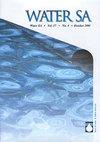Rapid detection of drug-resistant Escherichia coli by Vitek 2 compact system
IF 1.2
4区 环境科学与生态学
Q4 WATER RESOURCES
引用次数: 0
Abstract
Sewage treatment facilities aim to reduce biological contaminants such as pathogenic bacteria, fungi, protozoa, and viruses in wastewaters before discharging them to the receiving water bodies. However, several studies have shown the persistence of these contaminants throughout the sewage treatment process. In this study, the Vitek 2 compact system was used to detect the presence of Escherichia coli in three sewage treatment facilities located in the Pietermaritzburg urban area (South Africa), and its susceptibility to antimicrobial agents. E. coli has been recognized as an important Gram-negative rod-shaped human pathogen. The effluent and influent samples were analysed to determine the fate of E. coli and its susceptibility to 17 antimicrobial agents. The system identified the presence of drug-resistant E. coli in all of the tested samples, with the highest susceptibility being to ampicillin (33%) and trimethoprim/sulfamethoxazole (27%). The Vitek 2 compact system is a quick and powerful tool to identify antimicrobial-resistant bacteria in effluents and monitoring by this systemcan be used to prevent the outbreak of waterborne diseases.Vitek 2紧凑系统快速检测耐药大肠杆菌
污水处理设施旨在减少废水中的生物污染物,如致病菌、真菌、原生动物和病毒,然后将其排放到接收水体。然而,一些研究表明,这些污染物在整个污水处理过程中持续存在。在这项研究中,使用Vitek 2紧凑型系统检测了位于彼得马里茨堡市区(南非)的三个污水处理设施中大肠杆菌的存在及其对抗菌药物的敏感性。大肠杆菌是一种重要的革兰氏阴性杆状人致病菌。对出水和进水样品进行分析,以确定大肠杆菌的命运及其对17种抗菌剂的敏感性。该系统在所有检测样本中发现了耐药大肠杆菌,对氨苄西林(33%)和甲氧苄啶/磺胺甲恶唑(27%)的敏感性最高。Vitek 2紧凑型系统是一种快速而强大的工具,可以识别出水中的抗菌细菌,并通过该系统进行监测,可用于预防水传播疾病的爆发。
本文章由计算机程序翻译,如有差异,请以英文原文为准。
求助全文
约1分钟内获得全文
求助全文
来源期刊

Water SA
环境科学-水资源
CiteScore
2.80
自引率
6.70%
发文量
46
审稿时长
18-36 weeks
期刊介绍:
WaterSA publishes refereed, original work in all branches of water science, technology and engineering. This includes water resources development; the hydrological cycle; surface hydrology; geohydrology and hydrometeorology; limnology; salinisation; treatment and management of municipal and industrial water and wastewater; treatment and disposal of sewage sludge; environmental pollution control; water quality and treatment; aquaculture in terms of its impact on the water resource; agricultural water science; etc.
Water SA is the WRC’s accredited scientific journal which contains original research articles and review articles on all aspects of water science, technology, engineering and policy. Water SA has been in publication since 1975 and includes articles from both local and international authors. The journal is issued quarterly (4 editions per year).
 求助内容:
求助内容: 应助结果提醒方式:
应助结果提醒方式:


